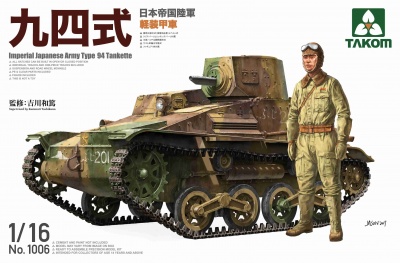SLEVA 20% DISCOUNT - Imperial Japanese Army Type 94 Tankette 1:16 - Takom
Starting in 1931, the Japanese Army began to consider the feasibility of a “mame-sensha,” or literally, a “bean-sized tank.” In May of the following year, the development of a battlefield support tractor was also discussed. These two points of discussion triggered the full-scale development of a troop-supporting auxiliary tank. To facilitate development, six Carden-Loyd Mark VIb tankettes were imported.
Based on the study of these tankettes, it was noted that although they were clearly insufficient as tanks, with an improved suspension they could have value as tank and infantry support vehicles. Specifications were created for a two-man vehicle weighing less than two tons, armed with a light machine gun, with armor resistant to light gunfire, and provisions for towing an ammunition trailer. Design development began in July of 1932, and in December of that year production orders went to Tokyo Gas Electric Co., Ltd., a civilian company.
A prototype was finished by March of 1933, featuring an original turret and suspension system, the engine and transmission located to one side of the hull, and a rear hatch for crew ingress and egress. It is thought that this design was heavily influenced by the French Renault AMR33 and the British Vickers light tank series, which have similar layouts.
In 1934 the refined prototype was given the designation “Type 94 Light Armored Car,” and “Type 94 Special Tractor” for the towing role. It was also called “TK” for the initials in its towing role. Both prototypes featured all-welded construction (production vehicles featured riveted and welded construction), with special steel plate for the armor. This 12mm armor could withstand 7.7mm bullet fire. Additionally, special steel was used in the construction of the thin tracks, for increased strength. The suspension consisted of two bogies per side with two road wheels on each bogey, with a new transverse-spring shock-absorbing system. This suspension system would be used as the basis for the suspensions of the next five Japanese tank designs. The turret was fitted with a 6.5mm Type 91 Vehicle-Mounted Light Machine Gun.
The vehicle was standardized in 1935 as the “Type 94 Tankette,” with the nickname “mame sensha” (“bean-sized tank”), and was deployed to each tank and infantry company, as well as 12 independently-formed light tank companies. 843 tankettes were produced by 1940, with the type seeing action during the war from China to Okinawa as Japan’s “fighting war horse.”

